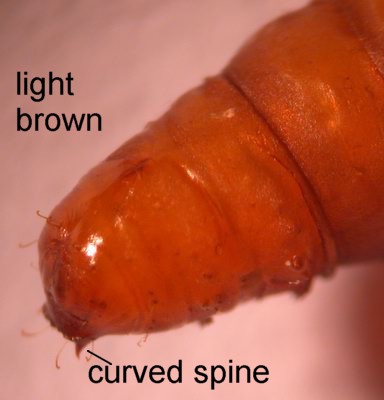49.051 BF1021
Flax Tortrix Cnephasia asseclana
([Denis & Schiffermüller], 1775)
Wingspan 15-18 mm.
A reasonably common species throughout Britain, occupying gardens, farmland and other open habitats, where it can often be found resting on trees and fences etc.
The adults fly between June and August, and are attracted to light.
The larvae feed on a wide range of herbaceous plants, mining leaves initially and then spinning together leaves or flowers.
- Larva: (description Ian F. Smith):
Foodplant: Over 130 species of plant, including Ranunculus, Plantago, Chrysanthemum, Lathyrus, Rumex, Teucrium and Atriplex. Sept. to June, most easily found April to June in spun leaves or flowers.
Early instar As late instar, below, with following exceptions.
Length: About 7 mm.
Head: Brown heavily marked black.
Prothoracic shield: Black or pitchy brown. Medial dividing line obscure.
Body: Brownish cream. (May vary with diet).
Anal plate: Entirely black or pitchy, except translucent whitish edges.Intermediate instar As late instar, below, with following exceptions.
Length: About 9 mm.
Body: Greyish green. (May vary with diet).
Anal plate: Black horseshoe mark broader and encloses anterior area of grey-green.Late instar Length: Description of 10 and 11 mm specimens.
Head: Light brown. Stemmatal area black. Bold black streak postero-laterally.
Prothorax (T1): Prothoracic shield brown, often heavily marked with black laterally, divided by whitish yellow medial line. Rest of prothorax whitish with large black rimmed spiracle, a black prespiracular pinaculum and a black subventral pinaculum.
Mesothorax (T2): Black pinacula; one large dorsal pair, one large lateral, two at spiracle level and one subventral.
Metathorax (T3): As T2.
Thoracic legs: Black, sometimes brown.
Body: Finely shagreened, whitish blue-grey. Dorsal line more translucent, showing darker viscera.
Spiracles: Distinct, with black or pitchy peritreme.
Abdominal pinacula: Distinct shiny black or pitchy. A1-A8 two pairs dorsal, one lateral, one subspiracular, one subventral. A9 one fused pair dorsal, one large lateral, one subventral.
Setae: White translucent.
Anal segment: Anal plate has a broad black horseshoe enclosing a light brown anterior area. Posterior and lateral edges translucent whitish. Prominent anal comb with six long black prongs. (In the photograph the black spot at the base of the comb is a frass pellet about to be passed and flicked away by the comb.)
Prolegs: Concolorous with abdomen. Black basal pinaculum on anterior of ventral prolegs and postero-laterally on anal prolegs.
Pupa: Light brown. Cremaster has two short curved cremaster spines and several bristles, distally thickened and bent into stout hooks.Similar species: C. incertana larvae retain a completely black anal plate in all instars. C. incertana pupa is dark brown or blackish, and the two cremaster spines are shorter and not curved.

 UKMoths
UKMoths 





